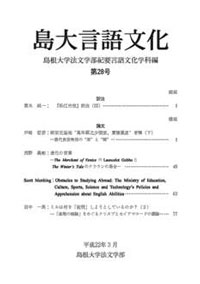島根大学法文学部
ISSN:1342-3533

ダウンロード数 : ? 件
この文献の参照には次のURLをご利用ください : https://ir.lib.shimane-u.ac.jp/3171
島大言語文化 : 島根大学法文学部紀要. 言語文化学科編 8
1999-12-25 発行
Cultural Diversity in the Classroom : Issues and International Perspectives
Murrow Patricia J.
英語コミュニケーション研究室
ファイル
内容記述(抄録等)
This paper compares some of the issues and challenges associated with cultural diversity, internationalisation and multiculturalism in the United States, Canada, New Zealand and Japan, and their impacts on elementary school education.
The terms multiculturalism and internationalisation are widely used, however the definitions applied differ with context. In this discussion multiculturalism is taken to be the knowledge and appreciation of, and sensitivity to diverse cultures, and the mechanisms by which this can be achieved. Internationalisation is defined as the ways in which international and intercultural dimensions are incorporated into the activities of an organisation.
In countries with long immigrant histories, cultural diversity in the classroom is inevitable. Rolls will include students with a strong links to their original ethnic ongins and those who are recent immigrants. Historically, the three western countries considered in this study have, to varying degrees, promoted assimilation based on an essentially mono-ethnic ideology dominated by white Anglo-Saxon values. However, in all cases, a multicultural approach is increasing favoured. This shift reflects external political pressures and the need to find educational mechanisms that better serve the modern reality. The search for mechanisms to provide an equality of education for a plurality of cultures while retaining national solidarity and promoting internationalisation and multiculturalism presents a major challenge.
In contrast, Japan, whose educational reform policies seek to equip students for the changes brought about rapid internationalisation, has an essentially monoethnic student population. This situation means that the challenges are different but no less difficult. While Japan does not have to find the means to service a plurality of cultures within its school system, it must nevertheless find ways to introduce an international dimension into its school curricula through an increasing emphasis on multiculturalism.
The terms multiculturalism and internationalisation are widely used, however the definitions applied differ with context. In this discussion multiculturalism is taken to be the knowledge and appreciation of, and sensitivity to diverse cultures, and the mechanisms by which this can be achieved. Internationalisation is defined as the ways in which international and intercultural dimensions are incorporated into the activities of an organisation.
In countries with long immigrant histories, cultural diversity in the classroom is inevitable. Rolls will include students with a strong links to their original ethnic ongins and those who are recent immigrants. Historically, the three western countries considered in this study have, to varying degrees, promoted assimilation based on an essentially mono-ethnic ideology dominated by white Anglo-Saxon values. However, in all cases, a multicultural approach is increasing favoured. This shift reflects external political pressures and the need to find educational mechanisms that better serve the modern reality. The search for mechanisms to provide an equality of education for a plurality of cultures while retaining national solidarity and promoting internationalisation and multiculturalism presents a major challenge.
In contrast, Japan, whose educational reform policies seek to equip students for the changes brought about rapid internationalisation, has an essentially monoethnic student population. This situation means that the challenges are different but no less difficult. While Japan does not have to find the means to service a plurality of cultures within its school system, it must nevertheless find ways to introduce an international dimension into its school curricula through an increasing emphasis on multiculturalism.
About This Article
Other Article
